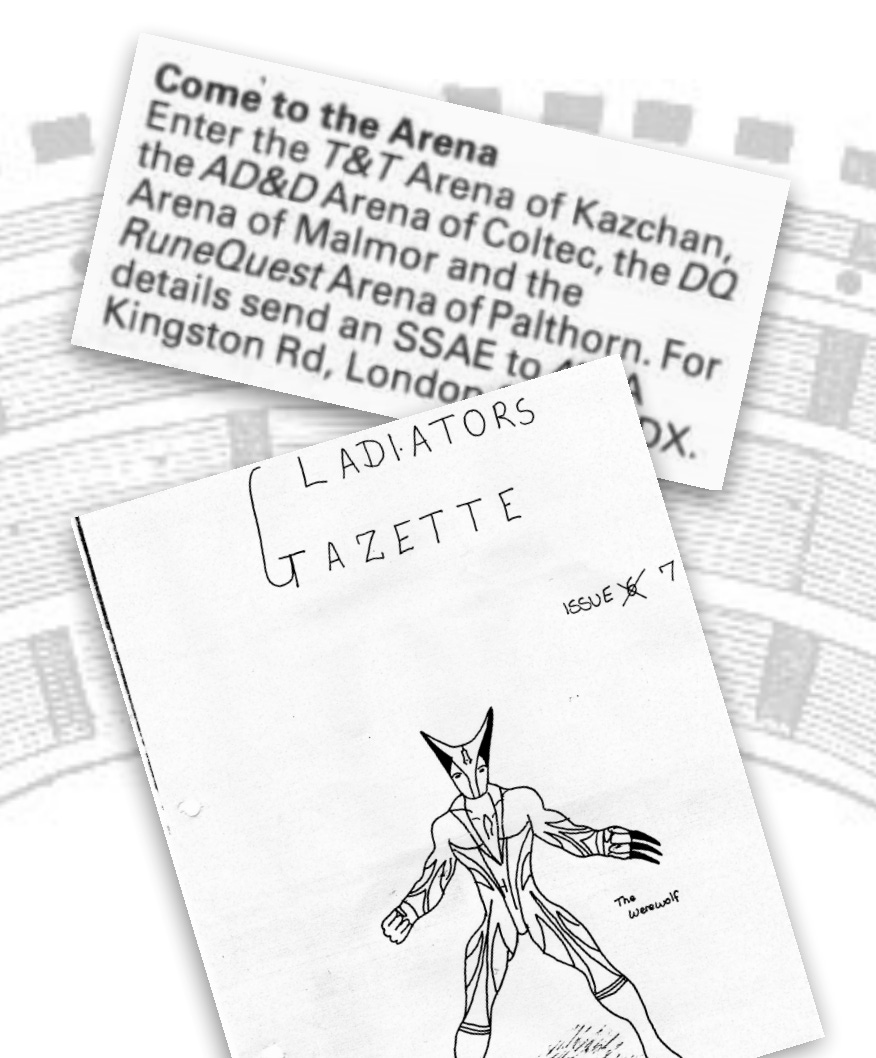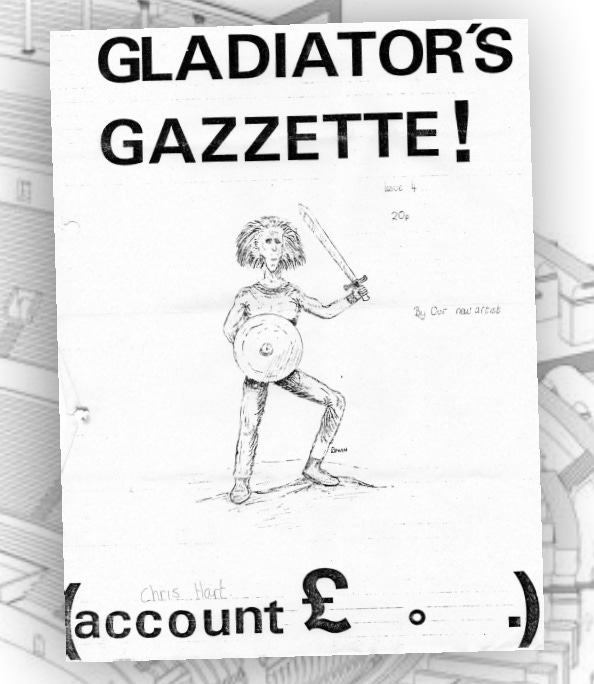"Blood and sand!" Gladiator PBM
As The GROGNARD files prepares to host a multi-player, online, Gladiatorial Arena in Autumn '25, Dirk the Dice reflects on the PBM that was the inspiration.
When White Dwarf landed on the doormat, the first page I scrutinised was the small ads section at the back. Reading those little capsuled lonely heart pleas for new players fascinated me, as did the gnomic phrases that advertised fanzines and requests for cut-price editions of Trollpak.
It was a proof that there was a role-playing life out there, beyond our small town. Other people WERE playing RPGs, we just needed to reach them.
At the time, even players in neighbouring towns of Chorley, Wigan and Salford seemed impossibly far away requiring logistical feats that our teenage brains were unable to fathom.
Although we played morning, noon and night during this period, there was always a sense that it was possible to squeeze even more games in to the day.
Postal games appeared a very attractive means of getting an extra hit of the hobby; like those dedicated smokers who use nicotine patches to supplement their habit, participating in postal games were an opportunity to keep playing when everyone had left the table to go home.
I would eventually lose my teenage years to running a PBM myself, but before then, I was lost in blood and guts of a Gladiatorial Arena.
HISTORY OF PBMS according to Dirk …
Even back in the 80s, playing games by post was not a particularly new phenomena. It’s been around since the nineteenth century when correspondence chess was popular; opponents sending their moves through the post in the form of coded coordinates. Turn-based board games or card games lend themselves readily to play by mail, as the hobby grew, so did PBMs.
In the early 70’s Diplomacy was a popular PBM with multiple players participating with a central games master to moderate the game. Diplomacy GMs would also produce a fanzine as a connective platform to allow players to understand the overall picture and to allow them to communicate with each other.
Flying Buffalo supremo Rick Loomis was an early pioneer of using computers to moderate PBMS. When he mustered out of the army, he invested in a $14,000 computer to moderate his game of Nuclear Destruction, which had gathered over 200 participants that he was trying to handle manually.
By the 80s, there were several commercially operated games advertised relentlessly in the UK. The most popular titles were:
TRIBES OF CRANE: Develop medieval wandering tribes such as merchants, sea-farers or war-like bands competing for supremacy.
STARMASTER: World building across the Universe
WARBOIDS WORLD: Computers and robots have taken over Earth and are fighting it out on the surface
CRASIMOFF’S WORLD: Construct a party of adventurers exploring a world wiped out by plagueDespite the appeal of these professionally created games, with their dot-matrix print outs and potential to interact with hundreds of other players, they didn’t appeal. They were far too expensive for one thing and they weren’t role-playing games either. I wanted to play more RPGs, not to manage civilisations, it was hard enough making sure I got to school on time, never mind maintaining the well-being of nations.
PLAY BY SNAIL
The first play by mail PBM that we were part of was one for basic D&D.
The small ad promised high adventure in the pursuit of the Treasure of Theil. Set in a dungeon, the brave warrior explored the ancient ruins belonging a long forgotten evil cleric, in the search of its treasures.
The game delivered on its promise of high adventure; if you like your adventure to be extremely slow. The DM insisted on ‘one instruction per turn’. It went something like this:
“You see a wooden door at the end of the corridor.”
“I will check for traps.”
(Place response in an envelope, not forgetting the Stamped Addressed Envelope, put it a post box, and wait at least 4 days for a response)
“There are no traps”
mmmm ponder the response for a few seconds, write underneath …
“Is it locked?”
(Place response in an envelope, AND the Stamped Addressed Envelope, put it a post box, and wait at least 4 days for a response)
“Yes. It is locked.”
This would go on and on, until after 6 weeks your brave warrior would get through the door only to find an empty room. It might seem poor form mocking from the future, with our knowledge of X Box super-fast broadband connectivity, but even then it seemed like a painfully slow experience.
COME TO THE ARENA
The GLADIATOR’S GAZETTE, like those early Diplomacy games, took the form of a fanzine, produced irregularly (although it aimed for every month) for 11 issues for just over a year, starting in the Summer of ’84. It was produced laboriously by a Games Master known as Beelzebul from the very gates of Hell, typed on a Gestetner Model 105; a copier that needed sheets of stencils that could not be corrected once typed, therefore it was littered with errors. Reading it now, I find the whole thing a bit baffling as it’s difficult to read with its crazy punctuation and spelling, but at the time it made perfect sense because I was completely immersed within the world created within it’s blue pages.
It was possible to generate characters using Tunnels and Trolls, Dungeons and Dragons, Dragonquest and Runequest. Your gladiator was then pitted against an NPC foe in a fight to unconsciousness. Your fate was in the hands of Lord Hendrick Helcroman, who would judge the outcome of the contests with the aid of his capricious, flirtatious wife Salina Trehan. The initial issues of the magazine were taken with giving a blow-by-blow account of the battles in the arena:
Vanis The Grim strides across the arena towards Tweedledum and Tweedledee, the two hobbits, swinging his broadsword and as they throw their two daggers, the half-orc seems to jump in the way of the dagger and falls to the ground then flops still.
Beelzebul encouraged players to make side-bets on the outcome of the fight. The odds and potential winnings were presented with fight description. To enhance this element, it was possible to have another character who didn’t enter the pit, but stayed ring-side, placing bets and antagonising the other players. The ‘Noticeboard’ page was used to issue threats to other players as well as offers of help.
By issue six, the ‘zine got into its stride, with a number of reoccurring characters establishing themselves. The ‘Noticeboard’ began to take over.
Through pithy missives between players the characters began to emerge and take centre place, pushing the actual battles to the sidelines.
Characters like Lyanna, an elf- warrior who had lost an arm during an unfortunate accident during training with a crocodile. She had a personal vendetta against all dwarves, collecting their ears to decorate her necklace and would use the ‘Notice Board’ to goad them. There was also Ulmas Grabb, who contributed a Gambling Column, offered gossip on the relationships between Lyanna and some of the other protagonists in the arena.
Ravening Death Shadows was a necromancer who terrified everyone in the arena by writing his threats in UPPER CASE. He was planning evil schemes along with the half-orc Ghoul Ash who was seeking followers to his death cult Leotrah’ha.
LIFE INSIDE THE WALLS
The fighting began to fade into the background, Life within the Walls became a soap-opera of the every day life of the internal workings of a Gladiatorial arena. This was years before the soapy swords and sandals Spartacus mini-series, but the lives and loves and deaths of the characters within the walls became incredibly important for the participants. It was very important to me.
My participation in the Gladiatorial Arena didn’t begin well. I was chastised in the first fight description, and exposed as some kind of role-playing charlatan, who didn’t really know what he was doing. The rules said that every player needed to give two instructions for each ‘round’ of the fight, which would then be described by Beelzebul. Whether my instructions were unclear or it was a misunderstanding, the first fight ended with the following:
“Only Rune Lords and Priests with an attack of 100% plus or more, or a character with two weapons may engage in two offensive blows in a combat round: STUDY THE RULES ON COMBAT, Please!”
I was raging about this slap-down for weeks, but undeterred, I carried on. My character was a noble. Marcus Mendusor (or Menduson, or Mendussour, or Mendusenon, I could never settle on a spelling) who fought valiantly in the first couple of issues, with some colourful results: “needless to say, with the general absence of a head, the Goblin suffers a terminal case of death.”
However, it also became clear that he was not really suited to the life of the gladiator. The meagre prize money was hardly an incentive for a wealthy noble.
He sought out a champion, someone who could do the fighting for him. He put out an advertisement, appealing for champions on the ‘Noticeboard’.
Initially, there was very little interest from the other gladiators in having a sponsor to pay for their training and funeral. Despondent at not getting recognition due to the clamouring voices of everyone else, he returned to fight in the pit.
In the arena, Marcus was confronted in the arena by his brother, who turned out to be a ghoul, for a reason that was never fully explained. He was the soul of an ancient ancestor that was tormenting Marcus, just for the sport of it. The story was neither explained or resolved, this was a continuing drama after all, you just needed to stick around for longer to find out what happened. The next major storyline involving Marcus followed a dramatic bout, he faced the Prince Regent in battle and lost.
Lord Hendrick, fearing repercussions, allowed Marcus to live.
Marcus conspired to avenge the humiliation in the arena by disguising himself and arranging a meeting with the Regent in THE MUTANT TORTOISE, the in-house tavern, where he poisoned his drink and clubbed the unsuspecting royal to death. This act of assassination seemed to offend everyone.
Marcus was arrested during the subsequent bar room brawl, along with many other denizens of the arena. Hendrick judged that everyone was guilty and needed to be punished. The noble remains in this purgatory to this day.
MEET THY MAKER
Gladiators Gazzette grew and grew. What started out as a couple of sides of photo-copied A4 ended up as 30 sides of compact type, with lots of games included, squeezing out the original concept. Inevitably, with the pressure of ‘end of term survival exams’ and other factors, the ‘zine folded in ’85. Shortly before it came to an end, I met Beelzebul in person at Dragonmeet, he was wearing a Gladiator’s Gazette T-shirt that he’d hand-drawn using felt-tip pens. It slowly began to run as the day progressed and it got hotter and hotter, until it eventually disappeared.
Faded away completely.
This article originally appeared in the GROGZINE which also includes an interview with Beelzebul himself. If you want to find out more about the online Gladiator Arena event, then check out The GROGNARD files Patreon for details.







"role-playing charlatan, who didn’t really know what he was doing" lol. Sorry, been there.